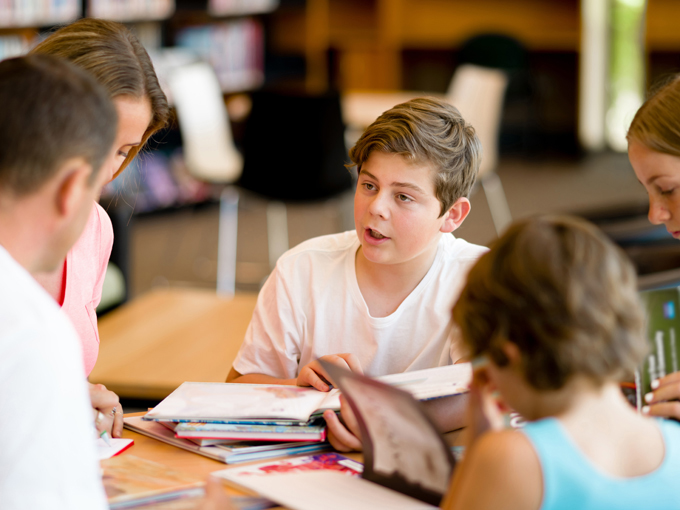 “I need your help putting some things in order. What I have here, I have a lot of pictures and the pictures aren’t in order. I don’t know which come first in the story. What is this?” Sarah, the teacher, asks the small group of students, ages 4 and 5.
“I need your help putting some things in order. What I have here, I have a lot of pictures and the pictures aren’t in order. I don’t know which come first in the story. What is this?” Sarah, the teacher, asks the small group of students, ages 4 and 5.
Edward answers, “Brushing your teeth.”
“So, what happens first when people brush their teeth?”
The small group works through the pictures and agree on the order: First you pick up your toothbrush (picture no. 1), next you put toothpaste on it (picture no. 2), next you brush (picture no. 3), and then, whatever the last picture is—students are unclear whether it’s flossing or checking the teeth—they decide it comes last (picture no. 4). They tell the story to Sarah, who nods and moves on to the next set of pictures in the sequencing task. She puts out four pictures of a log falling down a waterfall. The students confidently put them in an order that does not reflect a log falling down a waterfall. Sarah asks them to explain the story. Without skipping a beat, Edward explains, “Well, the log comes down the water and then goes back up.”
His classmate, Aliza, jumps in, “One log comes down and then another log comes down.”
“What if,” Sarah, dismayed, probes, “there was one log. Could it be a different order?”
Dismissively, Edward replies, “OK, the log goes down the waterfall around the stream, up, and down again.”
The students are committed to their story. They work hard to justify their sequence, in the process demonstrating the very cognitive aspect this sequencing task looked to measure: the ability to sequence the pictures and justify the sequence through narrative. What they’re not willing to do is revise their sequence to fit the narrative convention at play. Unlike brushing teeth, at ages 4 and 5, living in suburban Boston, these students don’t have enough experience with logs and streams to understand the story the cards are meant to convey. They are unfamiliar with the narrative conventions operating here. But this does not stop them. Rather, it allows them to construct creative interpretations. They were asked to put the picture cards in order and develop a story that reflected the order. And they did.
“OK,” Sarah hedges, in response to Edward’s revised story.
“Let’s do another one,” Aliza requests. Their story, like it or not, is complete.
The group moves on to three more sequencing tasks, one about scoring a goal in soccer, one about a melting snowman, and one about a friend knocking down another friend’s blocks. The group of students quickly sequence each set of cards in a standard order and tell a story that we, adults, would deem correct. But in this short opening task, the students have exposed a deep pedagogical insight: unconventional answers, that is, answers that ignore some convention for how textual meaning is produced, can often show deep disciplinary understanding.
Researchers in literacy education have repeatedly demonstrated the possibilities presented in unconventional interpretations. Maren Aukerman, for example, carefully documented how a fifth-grade student’s unconventional pronunciation of beast as best led to a rich, textually invested discussion between students. She also demonstrated how a student’s unconventional interpretation of a science textbook’s excerpt on spiders, nonetheless, displayed productive and insightful textual work. The student did not understand that the statement “Hairy Mygalomorphs are known by scientists as primitive spiders. They have existed for millions of years, yet have changed very little” referred to the species at large—not a single spider. This led to deep scientific exploration and close reading among the students in the class.
These examples highlight what so many teachers of texts already know: When students are afforded the opportunity to generate hypotheses about the text and make decisions for themselves about how different aspects of the text fit with their hypotheses, their literacy skills improve.
I was so deeply moved by observing the students in the interaction described earlier, not because the students were more capable of correctly sequencing those stories that were relevant to their lives. Rather, I was moved by the other side of that same coin, a side that has been mostly ignored by the research: how deeply motivated the students were to construct a story about the set of cards that was not relevant to their lives. Even when the students were unfamiliar with the narrative conventions at play in the waterfall and log set of cards, they were, nonetheless, deeply engaged and motivated to make meaning. Unlike adults, and many veteran school students, who learn to stop and silence themselves when confronted with an unfamiliar narrative convention, these young students marched forward, uninhibited, in their desire to make meaning.
As we help students develop the necessary skills for literacy, fluency, background knowledge, vocabulary, and comprehension strategies, we must always still attend to their most precious asset: an active desire to make sense of their worlds, even when this expresses itself in unconventional interpretations.
Ziva R. Hassenfeld, an ILA member since 2016, earned her doctorate in Curriculum and Teacher Education from Stanford University in 2016. She is currently a middle school teacher in the Boston area and a post-doctoral fellow at Brandeis University and at Tufts University.